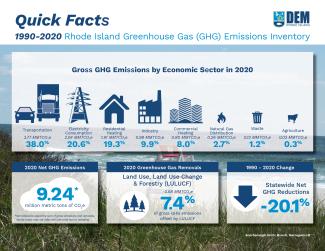2020 Greenhouse Gas Emissions Inventory Indicates Rhode Island Achieved First Act on Climate Mandate
Published on Friday, October 20, 2023
PROVIDENCE, RI – The Department of Environmental Management (DEM) announced today that Rhode Island achieved the first greenhouse gas (GHG) emissions reduction mandate set by the 2021 Act on Climate. In 2020, emissions decreased 20.1% below 1990 levels, more than twice the 10% reduction mandated by state law. On a shorter timescale, emissions decreased 6.5% between 2019 and 2020. In absolute terms, the state produced 9.24 million metric tons of carbon dioxide (MMTCO₂e) in 2020. The 2020 findings emerged from an annual analysis of Rhode Island’s GHG emissions conducted by DEM air quality specialists. Due to the reduced transportation activity in the first half of 2020 during the COVID-19 pandemic, the state’s emissions were significantly reduced beyond what would be typically expected. The absence of pandemic-related social and economic restrictions in 2021 will likely translate to a rebound in emissions in the upcoming 2021 inventory, expected to be published in fall of 2024. The annual inventory is the primary scientific tool for assessing progress toward the Act on Climate – authored by Senator Dawn Euer and Representative Lauren Carson and signed into law by Governor McKee in 2021 – to guide the state to net-zero GHG emissions by 2050.
“Rhode Island’s achievement of the Act on Climate’s 2020 emissions reduction mandate demonstrates what can be achieved through emissions reductions, particularly in the transportation sector,” said Governor Dan McKee. “At the same time, the 2020 inventory also underscores the continued work that is necessary through our collective climate action efforts to create a future of net-zero GHG emissions.”
“Meeting the 2020 mandated benchmark is a sign that Rhode Island remains on the right path for complying with the Act on Climate,” said DEM Director Terry Gray. “Both the heating and transportation sectors remain large sources of GHG emissions and primary drivers of climate change. It is critical that we remain focused on these sectors and continue our investments in renewable energy to meet our mandated emissions reductions for the future health and prosperity of the state.”
In 2020, most emissions emanated from three sectors: transportation (38.0%), electricity consumption (20.6%), and residential heating (19.3%). Transportation emissions shrank by 11.6% from 2019 levels, mainly due to large decreases in air travel and passenger vehicle traffic from pandemic related lockdowns. Emissions from consuming electricity increased 16.7% in 2020, partly due to regional economic forces and the closure of Massachusetts’ Pilgrim Nuclear Power Station in mid-2019. Residential heating emissions, sometimes referred to as part of the “buildings” sector, declined by 8.5% from 2019 levels. 2020 was, on average, a warmer year in southern New England compared to 2019. Reduced demand for natural gas and delivered fuel oil likely cut the state’s emissions from residential heating. On the longer timescale, emissions from transportation, electricity consumption, and residential heating decreased by 18.9%, 27.5%, and 19.8%, respectively since 1990. Rhode Island also continues to lose natural and working lands to development; the state’s forests removed 15.7% less carbon dioxide from the atmosphere in 2020 than 1990. For details on the emissions trends of other economic sectors, see the 2020 inventory's summary report.
The transportation sector continues to be largest source of emissions in Rhode Island. Although the pandemic-related emissions reductions should not be interpreted as an indicator of future emissions reductions, they can indicate how RI’s air quality could benefit from the switch to cleaner vehicles. In May, Rhode Island became the eighth state to propose the adoption the Advanced Clean Cars and Advanced Clean Trucks standards to rein in carbon pollution. Once fully implemented, this policy will help RI achieve net-zero GHG emissions by 2050.
The Rhode Island 2022 Climate Update, which was approved by the Executive Climate Change Coordinating Council (EC4) last December as the State’s official plan to mitigate climate change, recommended several methodology improvements to the annual inventory. In response, DEM updated the science used to compare the climate impact of methane and nitrous oxide to carbon dioxide, the most common GHGs. This year, DEM’s Office of Air Resources and Division of Agriculture and Forest Environment conferred with the U.S. Climate Alliance to align the inventory’s Land Use, Land Use Change, and Forestry (LULUCF) estimate with guidelines published by the Intergovernmental Panel on Climate Change. The inventory’s 1990 baseline, a critical dataset used to benchmark progress towards the Act on Climate, was also updated. DEM held a two-week public comment period and facilitated a public listening session with stakeholders to receive feedback on the 1990 baseline. For a comprehensive overview of methodology updates, see the 2020 inventory’s technical appendix.
Similar to other states that regularly perform economy wide GHG emissions inventories, Rhode Island relies on the U.S. Environmental Protection Agency’s (EPA) State Inventory Tool (SIT). Although EPA updates the SIT annually, there is a three-year lag between the end of the year being measured and publishing the GHG inventory in which to collect, compile, and verify the data. This lag affects the timing of DEM’s annual emissions inventories. DEM remains committed to improving the three-year lag time between the current year and the inventory year.
Click here for the state’s GHG inventory webpage. For more information on the state’s efforts to combat climate change and to find ways to participate, please visit www.climatechange.ri.gov.

